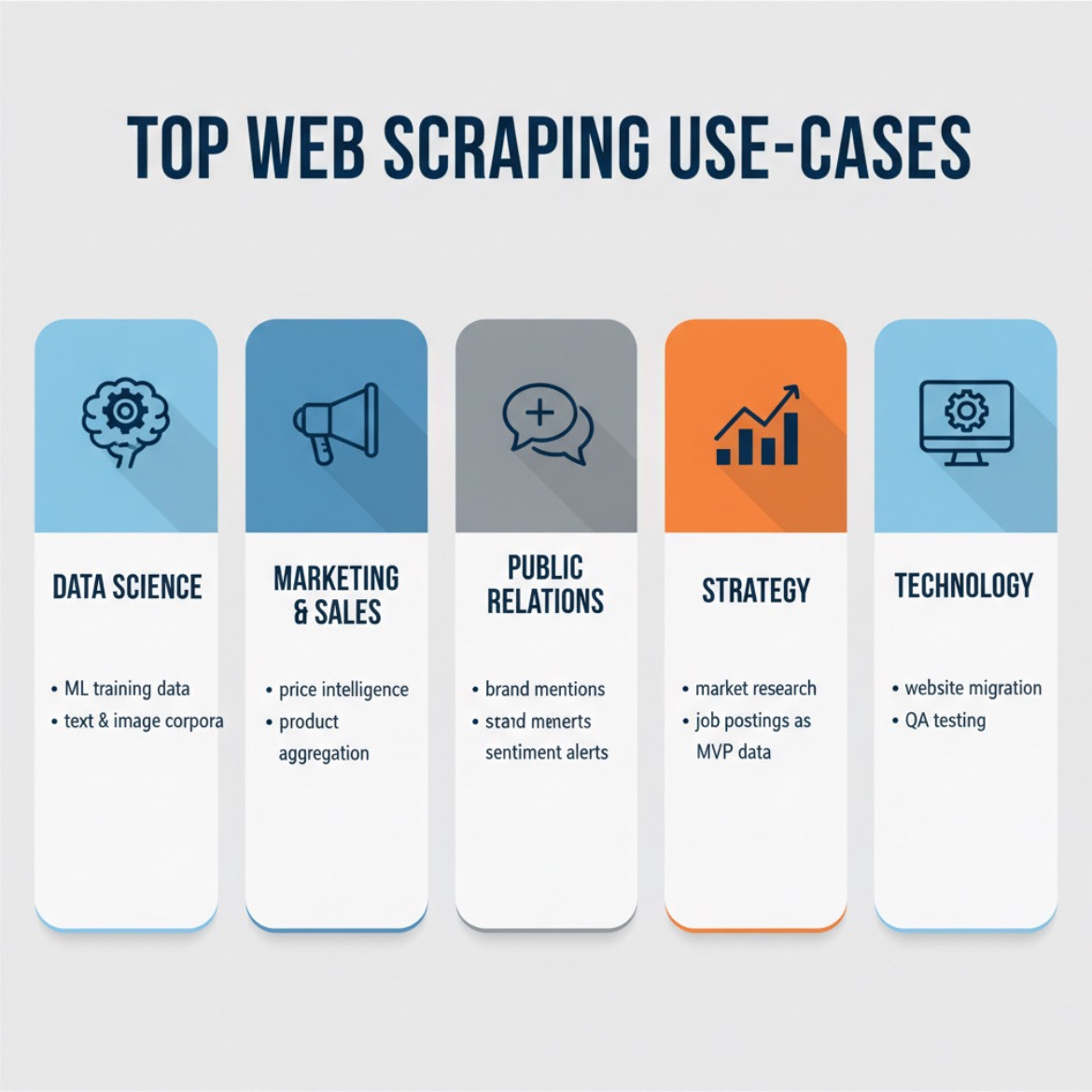Why Web Scraping Matters in 2025: Real-World Examples and Competitive Benefits
In today’s data-driven economy, actionable insight often starts with publicly available web data. Web scraping — the automated collection of website content — has become a foundational capability for companies that want to move faster than their rivals. But the important question isn’t can you scrape? It’s what do you do with the scraped data?
This article summarizes the main business use cases of web scraping, explains why each matters, and highlights practical trade-offs for teams considering a scraping initiative.
Why Web Scraping Matters Now
The web is a vast repository of signals revealing market dynamics, customer sentiment, competitor behavior, and even early indicators of corporate performance.
For organizations building data-driven strategies or machine learning models, scraping provides the raw material — large volumes of structured and unstructured data — needed to train models, monitor markets, and automate decisions.
Industry research (e.g., AIMultiple) shows that scraping underpins numerous business functions, from analytics to marketing to risk monitoring.
1. Data Science & Machine Learning: Feeding the Model Pipeline
Machine learning projects often succeed or fail based on the quality and breadth of training data. When internal datasets are limited, scraped web content — text, images, or product metadata — fills the gap, accelerating model development and improving generalizability.
Web data is especially valuable for natural language models, recommendation engines, and image classification datasets.
Analytical note: Treat scraped data as a raw input layer that must be validated and labeled. Without proper sampling, deduplication, and bias checks, adding more data can amplify noise or embed unwanted biases rather than improve model performance.
2. Marketing & Sales: Pricing, Competitive Intel, and Lead Signals
Scraping delivers immediate value for marketing and commercial teams:
Price intelligence: Continuous scraping of competitor product pages supports dynamic pricing and MAP compliance monitoring.
Product data aggregation: E-commerce firms pull product details, images, and stock info from suppliers to speed up catalog creation.
Lead generation: Public firmographic data and signals (promotions, new hires, funding, M&A news) help sales teams identify and prioritize prospects.
Analytical note: The key advantage here is speed. Pricing and availability data lose value quickly; the faster you detect and act, the greater the edge. Build pipelines that transform raw scrape results into operational triggers — e.g., automatic pricing updates or alerts to sales reps.
Practical tip: Start with a few high-value targets (top competitors, key SKUs) and expand as your ingestion and cleaning flows mature
.
3. Public Relations & Brand Monitoring
Scraping news sites, blogs, and forums enables near-real-time brand monitoring. Converting mentions into structured records (date, sentiment, source reach) allows PR teams to detect spikes — whether positive or negative — and respond quickly.
Beyond detection, scraping supports contextual analysis: what triggered the conversation, where it’s happening, and which messages resonate most.
Analytical note: Sentiment analysis over scraped data can be useful but should be validated — models often misinterpret sarcasm or domain-specific tone. Combine automated scoring with periodic human review.
4. Trading & Alternative Data
Hedge funds and quantitative investors increasingly use web-derived signals as “alternative data.” Scraped job postings, reviews, shipping manifests, or news articles can serve as early indicators of business performance.
The appeal is clear: if you can identify predictive signals before they appear in traditional datasets, you can build more timely trading models.
Analytical note: High-frequency access and rigorous back-testing are critical. Many scraped signals are noisy; the challenge is separating transient chatter from durable, predictive trends.
5. Strategy & Market Research
Scraping accelerates hypothesis testing for product managers and strategists. To size a market or validate a minimum viable product (MVP), teams need competitor lists, pricing structures, and feature inventories — all obtainable programmatically from public sites.
Scraping reduces the time and cost of market research while providing data that can be analyzed quantitatively.
6. Support Functions: Procurement & HR
Procurement teams use web data to track supplier health, monitor pricing trends, and evaluate risk exposure. HR teams scrape job boards and professional profiles to study talent supply, compensation ranges, and hiring trends.
These are practical, lower-profile use cases that directly improve operational efficiency and reduce risk.
7. Technology Uses: Migrations & Testing
Technical teams often scrape their own or partner websites to automate content migration, detect broken links, verify page renderings, or test QA workflows.
In this context, scraping functions as a tooling mechanism — not a competitive intelligence layer, but a critical part of reliable digital operations.
Key Risks and Operational Requirements
Web scraping’s benefits come with meaningful challenges:
Legal & ethical limits: Terms of service, copyright, and privacy regulations constrain what can be collected and how it’s used. Always consult legal counsel and adhere to platform rules.
Data quality: Large scraped datasets must be deduplicated, timestamped, and validated. Poor quality data can degrade models and mislead decision-making.
Infrastructure needs: At scale, scraping requires proxies, IP rotation, CAPTCHA handling, and site structure adaptation. Without robust infrastructure, pipelines are brittle.
Signal filtering: Especially in trading or marketing, raw feeds must be engineered into usable signals — otherwise teams drown in noise instead of insight.
A Pragmatic Framework to Get Started
Define the business question → What decision will this data enable?
Target the smallest useful dataset → Focus on high-value pages first.
Build a robust pipeline → Include ingestion, validation, storage, and integration.
Automate monitoring → Detect site changes, rate limits, and data drift early.
Govern data use → Conduct legal reviews, apply privacy filters, and define clear retention policies.
Conclusion
Web scraping is no longer a niche technical skill — it’s a strategic capability. From powering machine learning datasets to enabling dynamic pricing and alternative data signals, scraping helps organizations convert open web information into competitive advantage.
The edge doesn’t come from collecting data alone, but from integrating, validating, and operationalizing it responsibly. For teams building data portfolios or modern analytics pipelines, mastering ethical and scalable web scraping is a force multiplier for long-term success.


